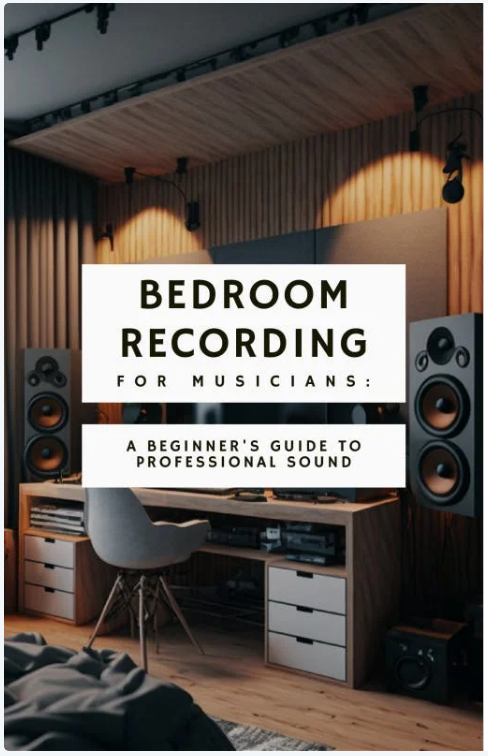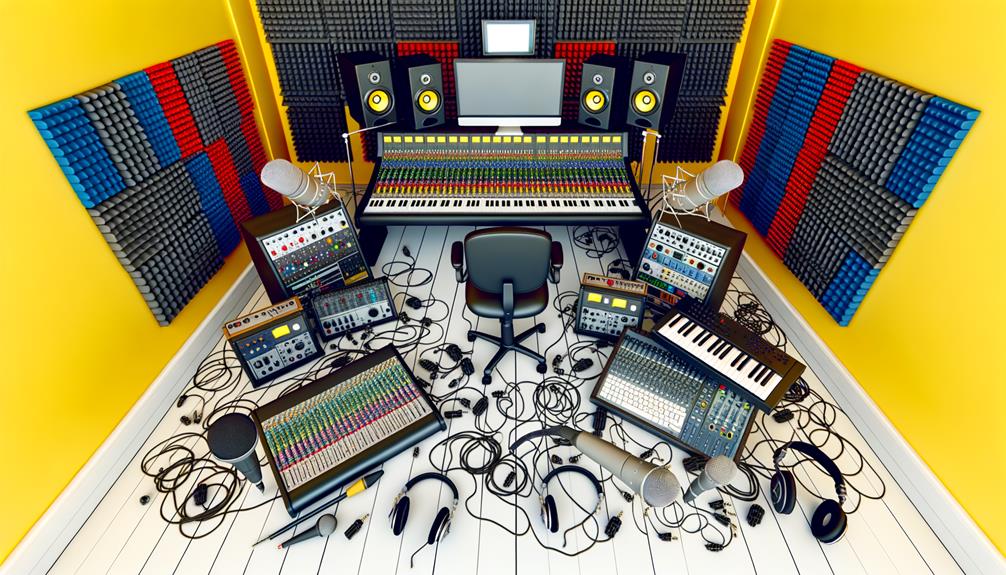Your music studio’s backbone consists of a reliable computer, a quality Digital Audio Workstation (DAW), and an audio interface matching your needs. Mics are essential; dynamic ones handle loud sounds, condensers capture detailed acoustic recordings, and ribbon mics produce warm tones. Don’t forget quality headphones for precise sound tweaking. Specialized gear, like a MIDI controller or advanced plugins, could further elevate your studio. Comfortable, ergonomic furniture is key too, it’ll make the long sessions much easier. But that’s just the start; much more awaits you when setting up your own studio. Want to uncover the rest? Stick around.
Understanding Different Studio Types
Let’s explore the four main types of music studios: the bedroom studio, the dedicated home studio, the semi-professional studio, and the professional studio. Each type offers unique advantages, tailored to fit varying levels of expertise and ambition.
In a bedroom studio, you’re likely starting your journey into sound creativity. With a modest budget, you can transform a corner of your room into a space for musical experimentation. You’ll need basic equipment, like an audio interface and a decent microphone.

Get Better Recordings
At Home
This is the perfect e-book for musicians and audio engineers looking to get started with setting up a successful bedroom studio.
For the dedicated home studio, you’re upping the ante. You’ve got a room dedicated solely to your music, with a larger budget for better equipment. You’ll pay more attention to soundproofing and acoustics, and may start investing in more specialized gear.
The semi-professional studio is where serious musicians or budding producers find their footing. You’ll need more advanced equipment, including a wider range of microphones and audio processors.
Essential Computer and Software
When building your music studio, the core and central part of your setup will be a reliable computer and the right Digital Audio Workstation (DAW) software. This isn’t just about getting the fastest machine, but also one that’s robust and can handle multiple tasks without slowing down. You’ll need a machine with a high-speed processor, ample RAM, and an SSD for faster data access.
The DAW is fundamentally your virtual studio. It’s where you’ll record, edit, mix and master your tracks. There’s a multitude of DAW software available, but a few standouts include Ableton Live, Logic Pro, and Pro Tools. They each have unique features that cater to different styles and workflows, so you’ll need to do a bit of research to see which fits your needs best.
In addition, you’ll need other software tools such as plugins, which will expand your DAW’s capabilities. These include virtual instruments, audio effects, and mastering tools. Some plugins are DAW-specific, while others are universal. Remember, investing in quality software will pay off in the long run, so don’t skimp on this central part of your setup.
Selecting an Audio Interface
So, how do you choose the right audio interface for your music studio? It’s not as intimidating as it might seem.
First, you need to determine your needs. How many instruments or vocals will you be recording at once? This will dictate the number of inputs you need.
Next, consider the type of connection your computer can accommodate. USB is common, but there are also FireWire, Thunderbolt, and PCIe options. Don’t get overwhelmed by the technical jargon, just match it to your computer’s capabilities.
Quality is key. Look for interfaces that have high-quality preamps and digital converters. They might cost a bit more, but the difference in sound is significant.
Lastly, think about your future needs. You don’t want to outgrow your interface in a year. So, consider an interface that can grow with you, perhaps one with expandability options.
Microphone Types and Uses
Have you ever wondered about the different types of microphones and their uses in a music studio? There’s a whole world of them designed for specific tasks, enhancing the quality of your recordings.
Dynamic microphones, for instance, are durable and great for recording loud sounds. They’re perfect for capturing robust vocals or the raw power of electric guitars.
Condenser microphones, on the other hand, are more sensitive and perfect for capturing acoustic instruments or delicate vocals in high detail.
Ribbon microphones are considered the vintage kings of warmth and are ideal for capturing smooth, vintage-sounding vocals and instruments.
Lastly, there are lavalier mics, which are small, clip-on microphones used mainly for spoken word.
But it’s not just about picking a mic. It’s about knowing how to use them. Understanding microphone polar patterns, for example, helps you best position your mic. Cardioid mics, the most common type, capture sound in front of them, rejecting noise from the back.
In the end, the perfect microphone isn’t the most expensive one—it’s the one that best suits your creative needs and enhances your sound. So, explore, experiment, and find your perfect match.
Importance of Quality Headphones
Just as important as a good microphone, investing in quality headphones can make a significant difference in your music production process. They’re not just for listening to your favourite tracks, but they serve as an essential tool for creating and fine-tuning your sound.
Where your room acoustics might be imperfect, and your studio monitors can’t be trusted for accuracy, your headphones come to the rescue. They can provide you with an intimate, detailed representation of your mix.
High-quality headphones can expose the tiny details you might miss otherwise, helping you to perfect your music.
Investing in Studio Monitors
Why should you invest in studio monitors for your music production setup? It’s important. Studio monitors, unlike regular speakers, provide a flat frequency response. They give you an accurate, uncolored representation of your music. This is essential when you’re mixing or mastering your tracks. You’ll catch every nuance, every detail, and you’ll know exactly how your music will sound on other playback systems.
But not all studio monitors are made equal. You’ll want monitors that can handle the full frequency range of your music, from low bass to high treble. Look for ones with bi-amp design for clean, distortion-free sound. Also, size matters. Larger monitors can produce deeper bass, but they may not be suitable for a small room as they can cause unwanted resonance.
Lastly, invest in monitors with innovative features. Some models offer room correction technology that automatically adjusts the sound based on the acoustics of your room. Others provide detailed EQ settings for further fine-tuning.
Enhancing Sound With Acoustic Panels
While quality studio monitors help guarantee accurate sound playback, you can further refine your studio’s sound quality with the strategic use of acoustic panels. These panels work by absorbing excess sound energy that might bounce off the walls and create echo or reverb.
Acoustic panels are innovative tools that can greatly enhance your sound. As you install them, target the reflection points in your room – the spots where sound waves bounce off the walls and back to your listening position. You’ll often find these points on the side walls, rear wall, and ceiling.
Incorporate panels that absorb a broad range of frequencies for a balanced sound. You’ll notice an immediate difference, with cleaner sound and reduced echo, making your recording and mixing processes more precise.
Remember, every room is unique, so you’ll need to customize your panel placement for best results. Don’t be afraid to experiment and adjust until you’ve achieved the finest sound.
Ultimately, acoustic panels are a cost-effective way to optimize your studio’s sound environment. By investing in these panels, you’re taking your studio’s sound quality from good to exceptional, allowing your creativity to truly shine.
Role of Mixing Consoles
In the heart of your semi-pro or pro studio setup, the mixing console serves as your command center, playing a pivotal role in managing multiple input sources and processing audio tracks. This game-changer device lets you fine-tune the sounds you’re working with, blending them perfectly to create a harmonious output.
The modern mixing console is a marvel of technology. It’s not just about adjusting volumes anymore. You can tweak frequencies, add effects, and experiment with sound in ways that were inconceivable a few decades ago. Imagine having the power to manipulate each individual sound in a symphony orchestra, controlling how they blend together, and you’ll get the picture.
As you advance in your music journey, you’ll appreciate the versatility that a mixing console offers. It’s your canvas, allowing you to paint with sounds, and craft your masterpiece. It’s where raw sounds get polished into a seamless composition.
Specialized Gear and Accessories
As you refine your studio setup, you’ll discover a world of specialized gear and accessories that can elevate your sound and streamline your workflow. These aren’t your everyday tools, they’re the little extras, the icing on your audio cake that can make all the difference.
Consider a MIDI controller for seamless integration with your Digital Audio Workstation (DAW). With responsive keys and pads, it’s a game-changer for composing, giving you hands-on control of your music.
Need to capture that crisp, clear audio? Opt for a high-quality condenser microphone. Pair it with a pop filter and you’ve got a winning combination for vocal takes that shine.
Don’t forget about those cables, either. Investing in premium cables ensures efficient signal transfer and reduces noise interference. You’ll be amazed at how much this can enhance the overall sound quality.
And finally, think about a reliable power conditioner. It’s not glamorous, but it’s essential. It’ll protect your gear from power surges and electrical noise, ensuring your equipment lasts longer and performs at its best.
Trust us, these specialized tools can take your studio from good to great.
Boosting Workflow With Ergonomic Furniture
Beyond the specialized gear, don’t underestimate the impact of comfortable and ergonomic furniture on your music production process. A well-designed chair and desk can make hours of mixing and mastering bearable, reducing physical strain and enhancing your workflow.
Consider an adjustable seat that supports your back and promotes good posture. It’ll help you prevent back pain and maintain focus during long sessions. An armrest can also be a game-changer, reducing shoulder tension and allowing for smoother movements.
Your desk is equally vital. Choose one with a spacious surface to accommodate your gear and provide easy access. If you’re into tech innovations, a standing desk might be a smart choice. It can facilitate movement, boost energy levels, and even stimulate creativity.
Also, think about your studio’s layout. Organize your equipment strategically to minimize unnecessary movements and maximize efficiency. For instance, place your most-used gear within arm’s reach.
Conclusion
So, you’re all set! With a reliable computer, the right DAW, high-quality audio interface, and studio-grade microphones, you’re on your way to making magic.
But remember, your headphones, acoustic panels, and ergonomic furniture are just as important. Sprinkle in some specialized gear, and voila! Your music studio is ready.
Dream big, work hard, and let the symphony of your creativity echo from your studio!
Ready to get started? Your musical adventure awaits!

